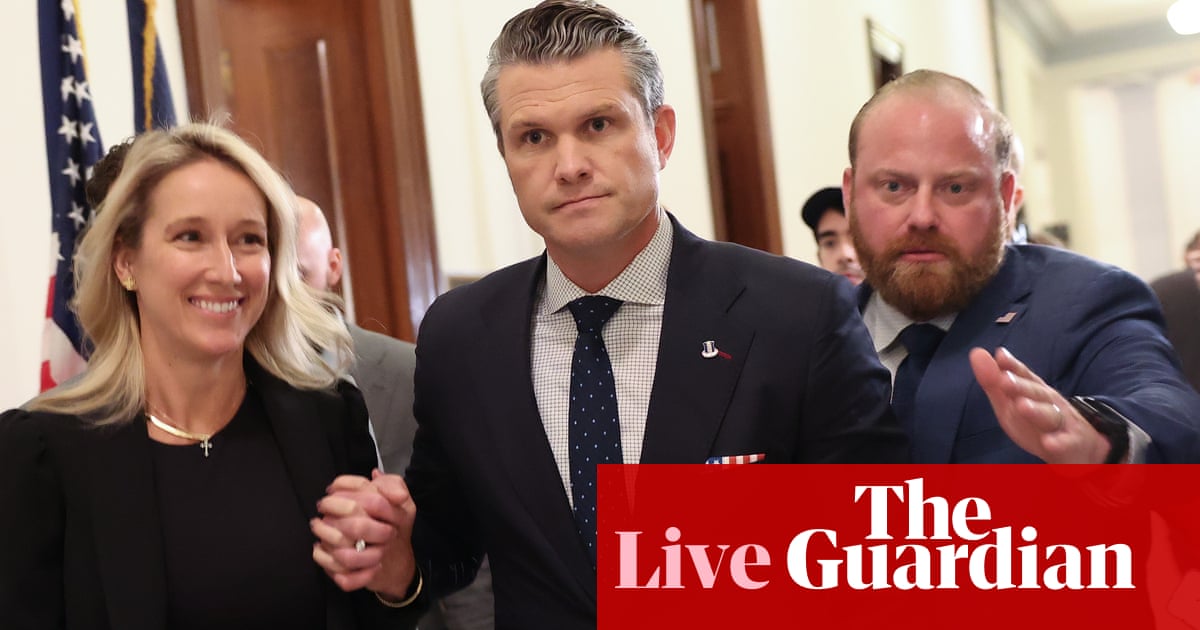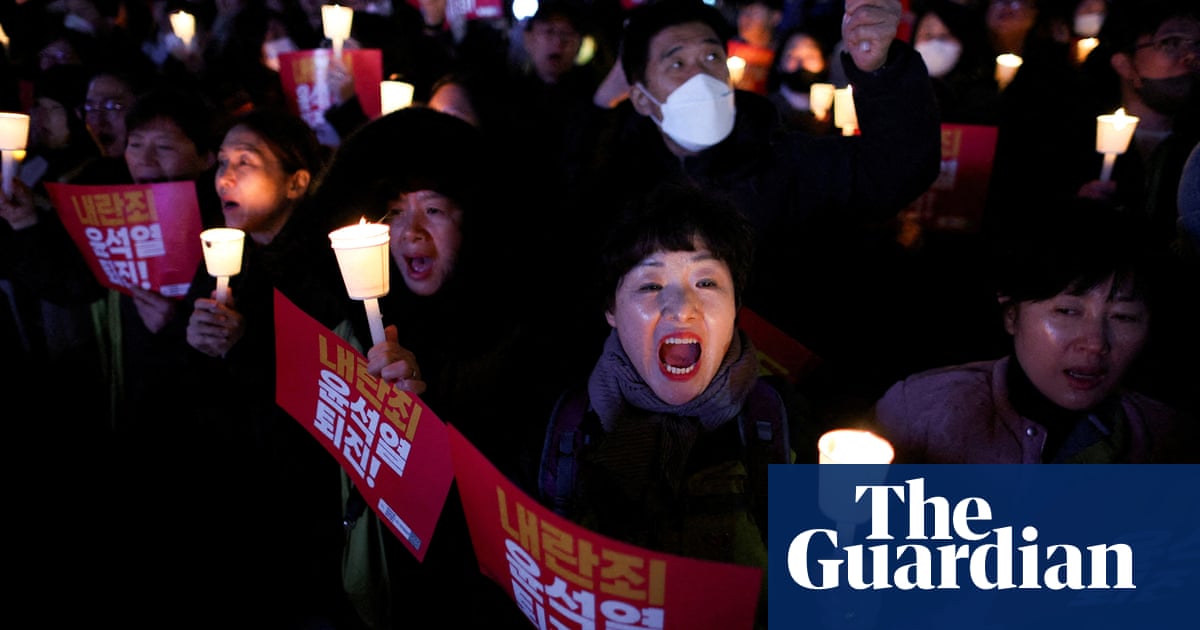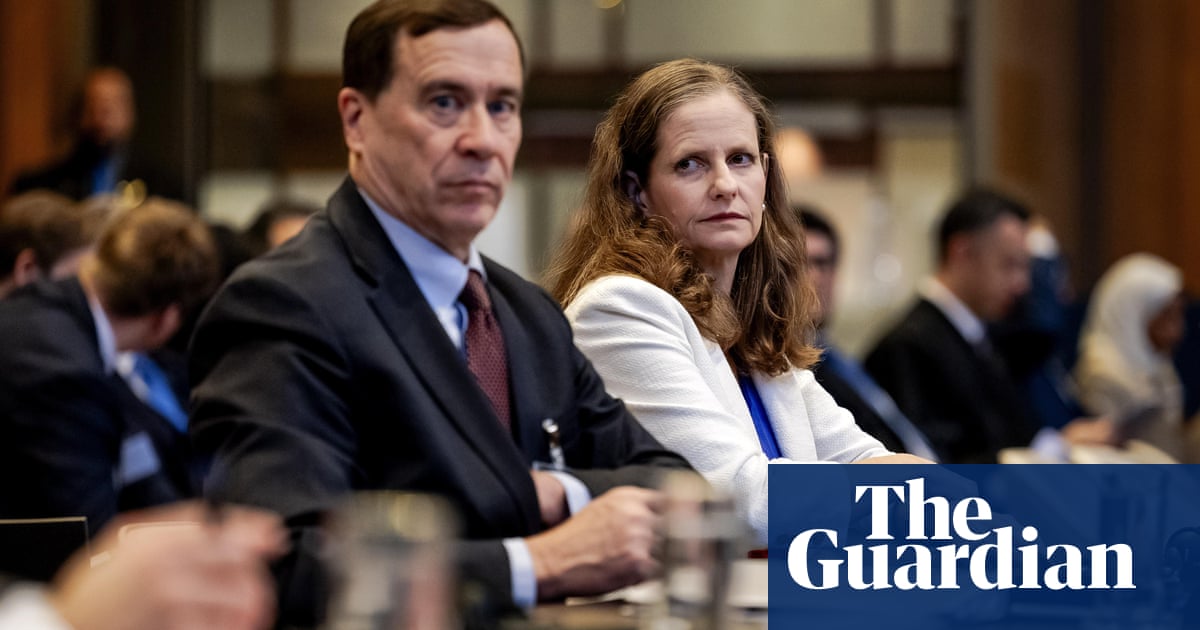Key senator says she’s still unsure about confirming Hegseth after meeting
Republican senator Joni Ernst, a sexual assault survivor and combat veteran whose views on Pete Hegseth are seen as crucial to his chances of being confirmed as defense secretary, declined to say how she would vote on his nomination.
Ernst met with Hegseth yesterday, and told Fox News this morning that she was not yet ready to say yes to confirming him.
âI think for a number of our senators, they want to make sure that any allegations have been cleared, and thatâs why we have to have a very thorough vetting process, and thatâs why I was happy to sit down with Pete and have that conversation with him yesterday,â Ernst said.
âSo, again, all I will say at this time is that we did have a very thorough discussion over a number of those issues. And the vetting will continue. I am certain, through the next month or so, until we approach that hearing date.â
Key events
Musk, Ramaswamy expected on Capitol Hill to stump for Department of Government Efficiency
Elon Musk has arrived at the Capitol for a meeting with lawmakers to promote the Department of Government Efficiency (DOGE), his Donald Trump-sanctioned effort to downsize the US government:
The Tesla CEO arrived with his son:
Biotech entrepreneur and former GOP presidential candidate Vivek Ramaswamy, who co-chairs DOGE along with Musk, is also expected to be around.
From the Associated Press, hereâs more on what the new department, which is not really a department and not actually in the government, may do:
Billionaire Elon Musk and fellow entrepreneur Vivek Ramaswamy are expected on Capitol Hill on Thursday, meeting with legislators behind closed doors about President-elect Donald Trumpâs plans to âdismantleâ the federal government.
Trump tapped the two business titans to head his Department of Government Efficiency, tasked with firing federal workers, cutting government programs and slashing federal regulations â all part of what he calls his âSave Americaâ agenda for a second term in the White House.
âI think thatâll be a great start to the whole process,â said Rep. Marjorie Taylor Greene, R-Ga., who will chair a House Oversight subcommittee in the new year as part of âbuilding the bridge between Congress and DOGE.â
Washington has seen this before, with ambitious efforts to reduce the size and scope of the federal government that historically have run into resistance when the public is confronted with cuts to trusted programs that millions of Americans depend on for jobs, health care, military security and everyday needs.
But this time Trump is staffing his administration with battle-tested architects of sweeping proposals, some outlined in Project 2025, to severely reduce and reshape the government. Musk and Ramaswamy said they plan to work alongside the White Houseâs Office of Management and Budget, headed by Trumpâs nominee Russ Vought, a mastermind of past cuts.
Acting secret service director acknowledges ‘abject failure’ in first Trump assassination attempt

Joan E Greve
The acting director of the US Secret Service, Ronald Rowe, criticized the events surrounding the first assassination attempt against Donald Trump as an âabject failureâ.
âJuly 13 was a failure of the Secret Service to adequately secure the Butler Farm Shows site and protect President-elect Trump,â Rowe told the House taskforce examining the assassination attempt.
âThat abject failure underscored critical gaps in Secret Service operations, and I recognize that we did not meet the expectations of the American public.â
Rowe took over as acting director of the Secret Service after his predecessor, Kimberly Cheatle, resigned amid bipartisan criticism of her agencyâs handling of security at Trumpâs campaign rally in Butler, Pennsylvania, which left the president-elect wounded and one attendee dead.
Since its formation shortly after the Butler rally, the House taskforce has conducted 46 transcribed interviews and reviewed roughly 20,000 pages of documents, chair Mike Kelly said.
Key senator says she’s still unsure about confirming Hegseth after meeting
Republican senator Joni Ernst, a sexual assault survivor and combat veteran whose views on Pete Hegseth are seen as crucial to his chances of being confirmed as defense secretary, declined to say how she would vote on his nomination.
Ernst met with Hegseth yesterday, and told Fox News this morning that she was not yet ready to say yes to confirming him.
âI think for a number of our senators, they want to make sure that any allegations have been cleared, and thatâs why we have to have a very thorough vetting process, and thatâs why I was happy to sit down with Pete and have that conversation with him yesterday,â Ernst said.
âSo, again, all I will say at this time is that we did have a very thorough discussion over a number of those issues. And the vetting will continue. I am certain, through the next month or so, until we approach that hearing date.â
Pete Hegseth has continued promoting his nomination for defense secretary on X, writing:
Maybe itâs time for a [defense secretary] who hasâ¦
Led in combat. Been on patrol for days. Pulled a trigger. Heard bullets whiz by. Called in close air support. Led medevacs. Dodged IEDs.
He has also retweeted favorable messages from Republican senators including Utahâs Mike Lee:
Weâre going to confirm @PeteHegseth !
And North Dakotaâs Kevin Cramer (who does not say exactly how he will vote on Hegsethâs confirmation):
The importance of a warrior for the war fighter cannot be overstated. The Secretary of Defense must be clear-eyed, mission-oriented, and vigilant on behalf of the men and women they lead. I appreciate @PeteHegsethâs willingness to serve. The scrutiny of the nomination process and transparency matter. I look forward to his hearing before the Senate Armed Services Committee.
Hegseth says Trump ‘supports us fully’ as he arrives on Capitol Hill
As the defense secretary pick arrived on Capitol Hill this morning for more meetings with Republican senators who will decide his fate, Pete Hegseth told reporters he has Donald Trumpâs full backing.
âI spoke to Trump this morning, just a few minutes ago. He supports us fully,â Hegseth said.
Asked about his meeting yesterday with senator Joni Ernst, Hegseth said it was âconstructiveâ and âcandidâ, but did not elaborate. The Iowa lawmaker and combat veteranâs support is seen as vital to Hegsethâs prospects of confirmation, but Ernst has said little about their meeting yesterday.
The New York Times also heard from two former employees of conservative group Concerned Veterans for America, which Hegseth led around 2015 as it struggled financially.
The former employees told the Times they remembered Hegseth as a good boss. The Times also reported that even though the group was in debt, Hegseth did not have full control over its spending:
Although he was listed as the chief executive officer, Mr. Hegseth did not have sole control over its finances. The organization was supported by a network of donors and operatives led by the billionaire industrialist brothers Charles and David Koch, and people familiar with it said its finances were overseen at least partly by officials at that networkâs umbrella organization at the time, Freedom Partners Chamber of Commerce.
Two former employees said they remembered Mr. Hegseth as a powerful voice for the organization who spoke emphatically about veteransâ issues and encouraged his audiences to vote.
Mark Lucas, who took over running of the nonprofit briefly after Mr. Hegseth left, said he found a well-run organization with knowledgeable and well-connected staff. âI didnât inherit anything from Hegseth that was a problem,â he said.
Matt Schuck, who booked some of Mr. Hegsethâs media appearances in late 2013 and early 2014, said he was a good boss. âI never saw anything out of the ordinary. I never saw him drinking heavily.â
Hegseth ‘upset’ after husband of woman he was having affair with showed up at Fox News party â report
Fox News human resources investigated Pete Hegseth after the husband of a woman he was having an affair with attended an employees-only Christmas party held by the network eight years ago, the New York Times reported.
Hegseth would go on to marry the woman, Jennifer Rauchet, who at the time of the incident was a producer on the show Fox & Friends. The episode threatens to be yet another troubling incident that could sour Republican senators on his candidacy for defense secretary.
Hereâs more about what happened, from the Times:
The âFox & Friendsâ Christmas party at a New York bowling arcade in 2016 was a low point. Mr. Hegseth, who was married to his second wife, with whom he had three children, was having an affair with Ms. Rauchet, a producer on the show.
Her husband, suspecting an affair, showed up at the party even though the event was limited to Fox News employees, and Mr. Hegseth, who had been drinking, was upset to see him, according to people with knowledge of the incident.
Employees reported that Mr. Hegseth caused a disturbance, a complaint that the human resources department addressed directly with him, according to one of the people with knowledge of the situation. After Mr. Hegseth and Ms. Rauchet disclosed their relationship to Fox News in late 2016, Ms. Rauchet was transferred to a comparable job within Fox News.
The Times also reported on an incident where Hegseth was so intoxicated at a Fox News colleagueâs wedding that his friends had to get him a ride home so he could make it to work on time:
The following December, Mr. Hegseth got so drunk at a wedding of a Fox News producer that he struggled to stand upright in a menâs bathroom, according to two people with direct knowledge of the episode who declined to be named for fear of retribution. Friends asked a producer who was there to get Mr. Hegseth a ride home so he could make it to the set by 6 a.m., they said.
Timothy Parlatore, Mr. Hegsethâs lawyer, said that âneither of these allegations are true.â
Fate of Hegseth nomination rests with key senator as more details of bad behavior emerge
Good morning, US politics blog readers. Donald Trumpâs nominee for defense secretary, Pete Hegseth, will be back once again on Capitol Hill today to try to convince Republican senators that heâs the right man to lead the Pentagon. Reports of excessive drinking, financial mismanagement and poor treatment of women, as well as a sexual assault allegation, have dogged his nomination over the past days, with several conservative lawmakers expressing doubts over approving him for the job. But the most important voice in determining his fate has not piped up yet: Iowaâs Republican senator Joni Ernst. The army veteran and sexual assault survivor met with Hegseth yesterday but said little publicly about their talk. Her views on him will be pivotal in determining whether the former Fox News hostâs nomination advances, or goes the way of Matt Gaetz.
Meanwhile, the New York Times has uncovered more details of incidents Hegseth was involved in while employed by the conservative network. These include another story of him drinking to excess, as well as an incident at a Christmas party eight years ago that led to an investigation from Fox Newsâs human resources department. Weâll see what Republican senators have to say about that throughout today.
Hereâs what else is going on:
-
Joe Biden and Kamala Harris will be together in public again at 6pm ET to light the national Christmas tree outside the White House. The pair have not been seen together much since Harris lost last monthâs presidential election to Trump.
-
Elon Musk and Vivek Ramaswamy are heading to the Capitol today to promote the so-called âDepartment of Government Efficiencyâ, their unorthodox, Trump-sanctioned idea to cut spending and downsize Washingtonâs federal organs.
-
The House committee investigating the attempted assassination of Trump will hear testimony from acting Secret Service director Ronald Rowe Jr, and will also mark up its final report.









